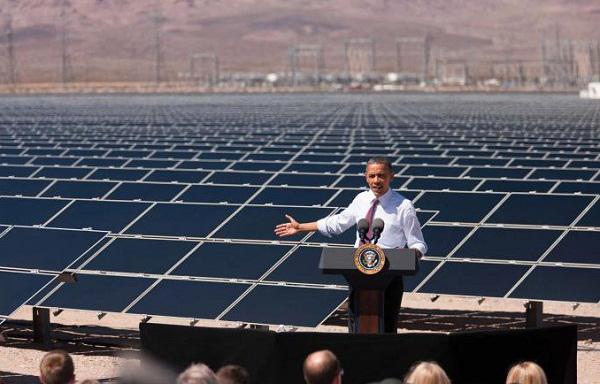Site it right– and there are 285,000 acres of public lands in six Western states to choose from – and big solar power developers might not find it too difficult to get utility-scale plant proposals through the environmental review process.
That’s the promise the Obama administration made on Tuesday, announcing it would publish a Final Programmatic Environmental Impact Statement for solar energy development on federally controlled land in Arizona, California, Colorado, Nevada, New Mexico and Utah.

The roadmap, which can be set in stone by Salazar after a 30-day comment period, opens up 17 “solar energy zones” for fast-track development, the administration also put 78 million acres off-limits.
“This blueprint for landscape-level planning is about facilitating faster, smarter utility-scale solar development on America’s public lands,” Secretary of the Interior Ken Salazar said in a statement. “This is a key milestone in building a sustainable foundation for utility-scale solar energy development and conservation on public lands over the next two decades.”
Publication this week of the Final PEIS culminates a process that began in December 2010 with an initial draft document. Last fall, the Interior Department announced a big revision of the draft, narrowing the number of solar energy zones from 24 to 17 and establishing a variance process to allow development on 20 million additional acres – but with a less streamlined process.
At the time, the solar industry expressed concern about losing flexibility in siting projects. Yesterday’s finalized version received what sounded like a cautionary vote of approval from the Solar Energy Industries Association.
“The PEIS identifies a process that will accommodate well-sited solar power plants outside of designated Solar Energy Zones and protects the rights of pending solar applications,” the SEIA said in a statement. “The Bureau of Land Management must ensure pending projects do not get bogged down in more bureaucratic process.”
Still, the benefits to siting projects in the solar energy zones will be substantial. The PEIS executive summary says the BLM will undertake activies such as “facilitating faster and easier permitting in the SEZs, improving and facilitating mitigation, facilitating permitting of needed transmission to the SEZs, encouraging solar development on suitable adjacent nonfederal lands, and providing economic incentives for development in SEZs.”
There are zones in six states, but that’s a little bit misleading: Of the 285,000 acres, more than half – 147,910 – are in Calfornia’s Riverside County, which borders Orange County on its western flank and then stretches all the way east across the Mojave and Colorado deserts to Arizona.
The Department of the Interior said the fast-track sites are “characterized by excellent solar resources, good energy transmission potential, and relatively low conflict with biological, cultural and historic resources.”

Pre-Obama, no big solar energy projects had been permitted on public lands. But according to the Interior Department, under Obama at least 28 renewable energy projects have been approved for construction on or involving public lands, including 16 solar plants, five wind farms and eight geothermal plants. In May, the first of those big projects – Enbridge Silver State North, a 50-megawatt solar PV array 40 miles south of Las Vegas – went online.
The administration says the push for more solar is part of a push for energy in general – an “all-of-the-above” strategy — and it is worth noting that the announcement on solar came one day after the administration said it will offer more than 20 million acres offshore Texas for oil and gas exploration.